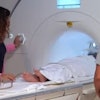CHICAGO - Agfa HealthCare is using this year's RSNA meeting to debut a new computed radiography (CR) offering and its Impax Enterprise integrated workflow package.
CR
Agfa gave center stage to its new CR product, the DX-S, which integrates two technologies unique to the vendor, DirectriX and Scanhead. DirectriX is a needle-based detector technology and Scanhead is a line-to-line CR simulation and light collection technology. The vendor believes that the DX-S offering bridges the gap between traditional CR and more expensive DR solutions, which offer high image quality but lack the flexibility required by departments such as general radiology, pediatrics, and the emergency room.
The developer said that the DX-S provides the capability for increased image quality and the potential for patient x-ray dose reduction through its DirectriX technology. High-speed imaging is accomplished through the use of the Scanhead line-to-line CR stimulation and light collection technology, which can finish a scan in approximately 15 seconds, according to the firm.
The DX-S is available in a mobile design configuration, which increases the capabilities for its deployment at point-of-care areas throughout a facility. This allows radiology personnel to remain with patients during image capture and processing, increasing patient satisfaction and comfort, and ensuring immediate quality control that reduces examination time, the company said.
The DX-S is currently available worldwide.
Agfa spotlighted a work-in-progress, the CR 20, a low-cost desktop CR model that is slated for market release in the third quarter of 2006. In addition, the developer demonstrated the next iteration of its NX CR interface software, due for U.S. release in the second quarter next year, which is based on Microsoft's .NET platform. The application boasts a combination of touch-screen, mouse, and keyboard input capabilities designed to ease a technologist's workflow, while still providing advanced image processing, work list, routing, and demographic features.
PACS
Agfa is celebrating the launch of its Impax Enterprise integrated workflow concept. Impax Enterprise consists of the vendor's Impax 6.0 PACS network, Impax RIS, System Monitoring & Management Services (SMMS), Impax Reporting, and Impax Auditing and Integration Services, according to Lenny Reznik, director of image and information solutions.
Impax Enterprise allows for users to securely access patient images, past studies, key RIS information, and procedure reports with a single log-on, according to the vendor. They can also access image processing tools and features to automate workflow, reduce number of mouse clicks, and boost throughput, Agfa said.
Enterprise Clinical Dashboard offers a way for referring physicians and radiologists to review complete patient results from departments such as radiology, cardiology, laboratory, and pathology, Reznik said. Impax Enterprise is available now.
First shown at the 2004 RSNA meeting, Impax 6.0 is now commercially available. A Web-deployable application, Impax 6.0 features a persona-based design, allowing the package to meet the workflow requirements of multiple users, he said. Target users include administrators, radiologists, PACS administrators, technologists, clinicians, and IT specialists. Other features include integration with third-party 3D software,
Agfa is also pointing to a RIS/PACS configuration targeted at imaging centers. The offering features a RIS designed specifically for imaging centers, Reznik said.
As part of its strategy of expanding its reach to the enterprise, Agfa is also showing off the results of its acquisition of cardiac image management firm Heartlab, he said.
In other product developments, Agfa is displaying a work-in progress EKG portal, a vendor neutral application that allows for presenting EKG results in a digital format, Reznik said.
SMMS
Agfa unveiled a major new component of its workflow solution suite, Impax System Monitoring & Management Services (SMMS). Agfa Impax SMMS, commercially released this past summer, is a 24-hour, 7-day a week proactive monitoring service for Agfa diagnostic and archiving hardware, applications, and databases.
The SMMS product has been designed to help identify ways of resolving specific issues and catching potential ones, through a connection to Agfa's global network of support centers. The monitoring service provided by Impax SMMS is linked to Agfa's technical call centers via a secure remote service system (SRSS).
The new system provides remote service in several ways, including point-to-point virtual private network (VPN) and router-to-router connections. Technical alerts are sent to Agfa's call center specialists, in addition to designated system administrators at each facility, so that repairs can be initiated before system performance is compromised. Most issues are typically addressed remotely within 30 minutes, the vendor said, and those requiring onsite service can be handled within a specified time frame.
The firm believes that Impax SMMS will increase the reliability of the overall healthcare infrastructure, while at the same minimizing the efforts required by administration and IT personnel to manage the integrations between HIS, RIS, PACS, CR, and other systems and modalities at an institution.
Imagers
In printing developments, Agfa is displaying new, works-in-progress features for its DryStar 5500 imager. The vendor is readying a mammography capability as well as the addition of three interchangeable trays, allowing for printing of 8 x 10-, 11 x 14-, and 14 x 17-inch films, according to the firm. Availability of the new features is expected in the first quarter of 2006.
The vendor is also unveiling its 5302 imager. A smaller version of 5500, 5302 includes two trays and has an approximate list price of $40,000.
In addition, Agfa is touting the benefits of its A#Sharp image sharpening algorithm. A#Sharp sharpens the images to produce a wet-laser look, according to the vendor.
Speech recognition
The vendor showcased its TalkStation 3.1 speech recognition (SR) software to RSNA attendees in the McCormick Place exhibit halls. The application features the capability to accept voice input from a multitude of devices including remote phone dictation as well as conventional microphones. The firm has a new mammography component that includes the American College of Radiology's BI-RADS categories.
By Erik L. Ridley and Jonathan S. Batchelor
AuntMinnie.com staff writer
November 28, 2005
Copyright © 2005 AuntMinnie.com



















